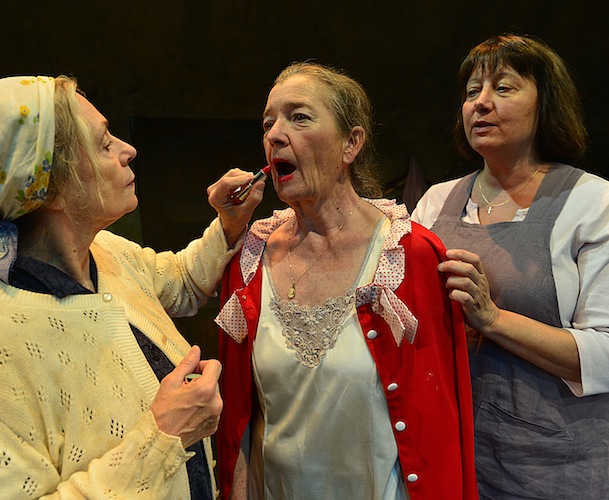Fuse Theater Review: “The New Electric Ballroom” — Life’s Stark But Beautiful Melodies
Like Samuel Beckett, Enda Walsh does not ignore the tenderness that flourishes, often under the duress of absurdity.
The New Electric Ballroom by Enda Walsh. Directed by Robert Walsh. Presented by Gloucester Stage Company, Gorton Theatre, 267 East Main Street, Gloucester, MA, through August 15.

L to R: Marya Lowry (Clara) Nancy E. Carroll (Breda), and Adrianne Krstansky (Ada) in the Gloucester Stage Company production of “The New Electric Ballroom.” Photo: Gary Ng.
By Robert Israel
The New Electric Ballroom is a gem of a play but it is not a polished gem, and that is one of its considerable strengths. The script is more of a homely bauble than a chic rock, proffering an elemental beauty that isn’t concerned with calling attention to itself. It has been fashioned to be seen and appreciated over the long haul, not simply ahhed over in a moment. Written by Enda Walsh, a gifted Irish playwright who owes more than a tip of the shamrock to Samuel Beckett, the drama in receiving a fine New England premiere production from the Gloucester Stage Company, which is fielding a gifted ensemble cast of four players who, under Robert Walsh’s insightful direction, inhale and exhale the distinct sounds, flavors, and adroitness of the Irish language.
Set in a small fishing village on the west coast of Ireland, the play introduces us to three sisters who, from the onset, live commingled lives that are deeply anchored to the past. “By their nature people are talkers,” Breda (Nancy E. Carroll) says, back turned to the audience, as the evening begins: “You can deny that. You could but you’d be affirming what you’re trying to argue against and what would the point of that be?” Over the course of the play’s taut 80 minutes, we hear a lot of talk, many phrases are repeated for their musicality, and the effect is riveting as we are learn more about each character’s peculiarities.
Breda chronicle about her misspent youth is heartbreaking because she whispers rather than shouts her despair. We are given teasing wisps of memories, tantalizing details of a wasted adolescence, of desires unfulfilled, of a continuing and cripplling anxiety. As her sister Clara, actress Marya Lowry wraps herself in personal tragedy as tightly as she ties her babushka around her head; we sense that her misfortunes have dug in deep. She, too, is given moments of reverie, wistfully stepping into the spotlight to remember her pain. And, as Ada, the adroit Adrianne Krstansky shares intimations of her paralysis though gesture and nuance rather than words. The cast is rounded out by Irish native Derry Woodhouse, who plays the fishmonger Pasty, a comical figure from the docks, who, bearing pails of fish, enters the sisters’ home through a lopsided door. Patsy and the fish — splayed bug-eyed on a bed of ice — are fused. He can’t help but feel connected with the seagulls that follow him about, hoping for a stray tidbit. Woodhouse’s performance is the tie that binds; his eccentricities and longing for love serves as a paradoxical magnet — it unites the sisters but also keeps them apart.

L to R: Derry Woodhouse (Patsy), Marya Lowry (Clara), Nancy E. Carroll (Breda), and Adrianne Krstansky (Ada) in the GSC production of “The New Electric Ballroom.” Photo: Gary Ng.
Walsh’s homage to Beckett is made plain via the small tape recorder that the sisters turn on and off to record memories or play haunting music. In Beckett’s one-act masterpiece Krapp’s Last Tape the besotted curmudgeon Krapp uses a tape recorder to listen to himself when he was younger, at one glorious moment wondering at fleeting moments of sexual fulfillment in the bottom of a punt: “We lay there without moving. But under us all moved, and moved us, gently, up and down, and from side to side.” Beckett strips language down, hand scrabbling for its starkest melodies; so does Walsh. Beckett was disdainful about Ireland and refused to return to his homeland, but he could never rid himself of the influence of its language on his work. In many ways, the comic character of Pasty pays homage to Beckett’s clownish tramps in Waiting for Godot, wrangling for dignity in a world far too ruined to entertain such impetuous notions.
The set design by Jenna McFarland Lord takes us, with compelling intimacy, into the cramped world of the three sisters (perhaps there is a touch of Chekov here as well?). Russ Swift’s lighting dramatically (but never intrusively) accentuates the moments when the sisters share their stories. His use of backlighting is particularly effective when Patsy enters and exits through the lopsided door, allowing us to catch fleeting glimpses of the rocky world beyond the sisters’ seaside cottage. And Miranda Giurleo’s costumes work wonderfully, particularly when the sisters put on the dresses of their youthful follies — the frills and color of the fabric provide a startling visual contrast to the attenuation of the present.
Like Beckett, Walsh does not ignore the tenderness that flourishes, often under the duress of absurdity. He makes more of this sensitivity in his way. Beckett’s figures are often rooted in the earth, trapped in cycles of confession. For Walsh, the process of peeling away the lies and illusions that weigh us down makes us lighter, providing a glimmer of hope that we might, one day, free ourselves from all that drags us down.
Robert Israel writes about theater, travel and the arts, and is a member of Independent Reviewers of New England (IRNE). He can be reached at risrael_97@yahoo.com
Tagged: Adrianne Krstansky, Edna Walsh, Gloucester Stage Company, Marya Lowry, Nancy E. Carroll, Robert Walsh
